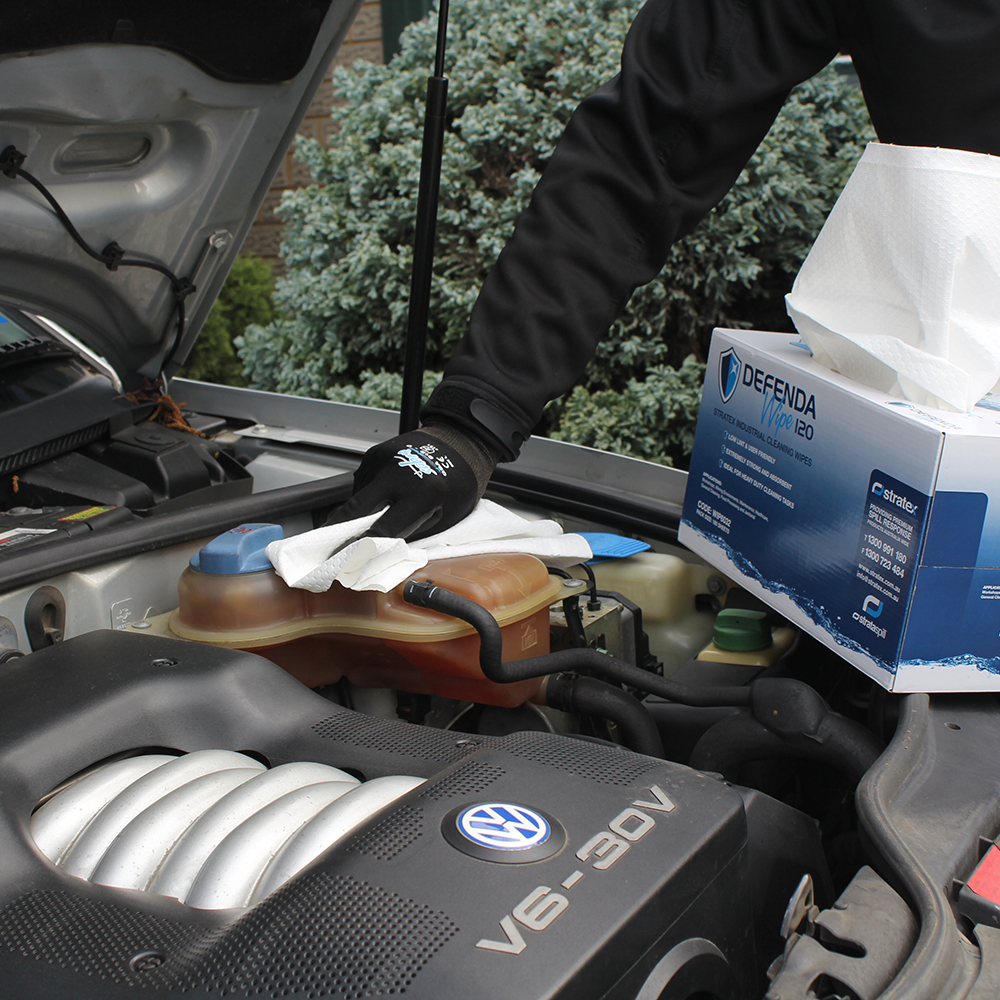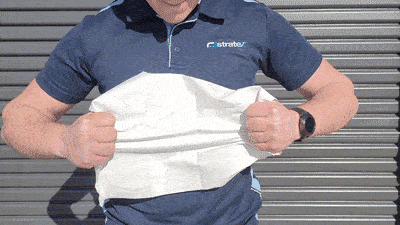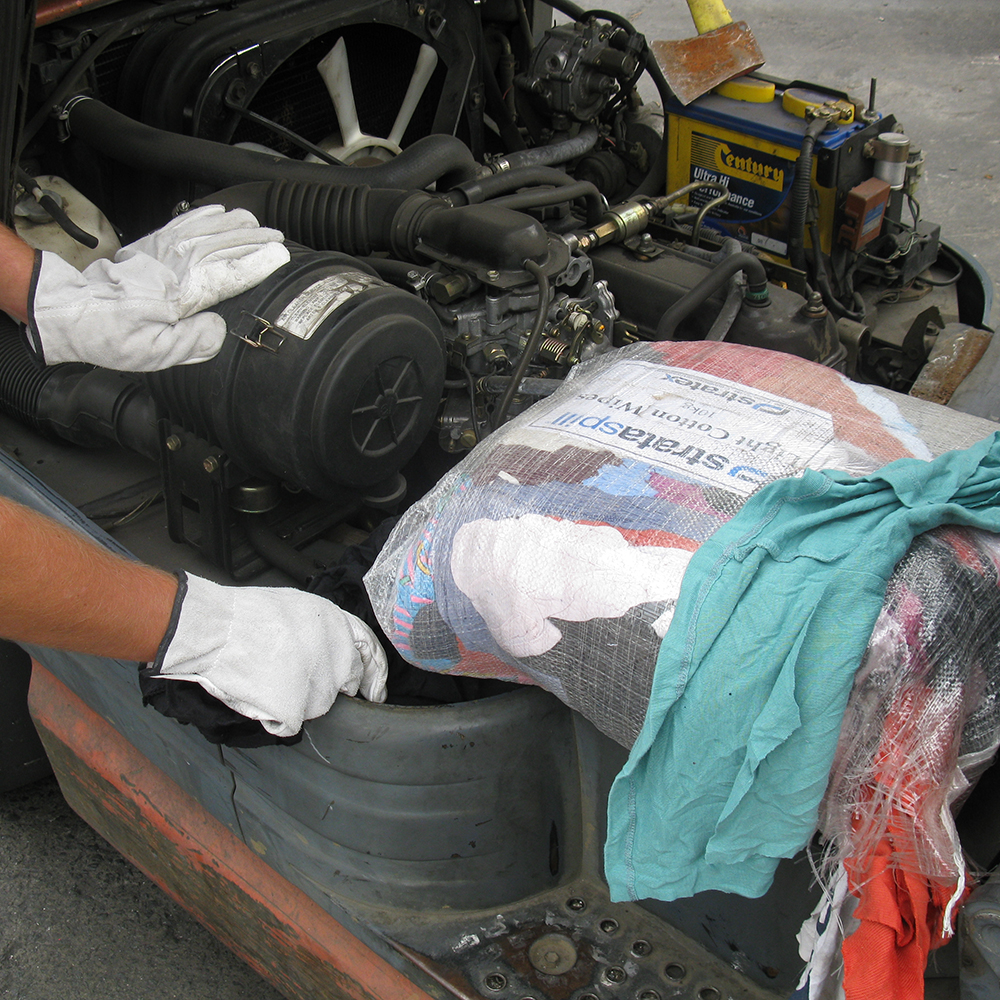
Are Wipes or Rags Better?
Let’s face it, wipes and rags are pretty similar. From soaking up spills to wiping down surfaces, they basically perform the same task. Many businesses tend to use one over the other, and the reason? Because it’s always been that way! At Stratex we offer both rags and wipes, and in this article we’re objectively comparing the two across a range of criteria. We’ll compare wiping, absorbency, storage footprint, value and environmental impact to definitively answer once and for all, which is better – rags or wipes?

Round 1: Wiping
Wiping is defined as the act of cleaning or drying a surface. You might wipe something to remove chemicals, grease, water or food.
Rags are made up of different types of fabric, cotton, polyester, nylon, rayon or various blends. All of these materials vary in their thickness, absorbency and wiping performance. Rags are derived from clothing and bedding, which means that wiping is a secondary utility. Because of this, rags can have a tendency to smear. Rags wiping score: 3/5 stars ⭐⭐⭐
Wipes (more specifically, DefendaWipes) are usually made from spunlace nonwoven composite, which is derived from renewable wood pulp fibres. Spunlace construction also reduces lint, the fine and short fibres which remain on a surface after wiping. Unlike rags, wipes are designed specifically to wipe. Because of this you can expect consistent workflow and efficiency performance from wipes. Wipes wiping score: 5/5 stars ⭐⭐⭐⭐⭐
Best for wiping: Wipes
The primary use of wipes is to wipe – They perform this task efficiently and effectively with minimal lint or residue.
Round 2: Absorbency
This round is similar to wiping, here absorbency relates to the rag or wipes ability to soak up spilled liquid.
Rags are made from various materials, limited their ability to effectively absorb spills. As such, more rags may be required than wipes to soak up an equivalent spill. Some fabrics such as polyester and polyester/cotton blends are less absorbent than 100% cotton. Rags absorbency score: 3/5 stars ⭐⭐⭐
Many Wipes utilise embossing which can aid to lift liquid upwards, away from hard surfaces. Simply placing an absorbent wipe over a liquid spill can absorb without leaving residue. Stratex offers DefendaWipes in two thicknesses, 60gsm and 120gsm. By weight, both are equally absorbent. Wipes absorbency score: 5/5 stars ⭐⭐⭐⭐⭐
Best for absorbency: Wipes
Most wipes are designed for superior wiping and absorbency performance. Generally wipes will absorb more liquid, and faster when compared with rags.

Round 3: Strength
In this round we’re going to compare the wet and dry strength of wipes and rags.
Made from fabric, rags are resistant to tears and abrasions. Rag strength is not compromised, even when soaked with fluid. Rags strength score: 5/5 stars ⭐⭐⭐⭐⭐
Wipes – we can’t speak for all wipes but most are offer high strength. To demonstrate our DefendaWipe strength we often ask our clients to grab each end of a DefendaWipe and pull – it’s difficult to tear. Replicating this test using a wet wipe produces a similar outcome – a true testament to their strength. Wipes strength score: 5/5 stars ⭐⭐⭐⭐⭐
Best for strength: Rags and Wipes (DRAW)
Advancements in technology mean that materials and construction have come a long way. The strength between rags and wipes is comparable.
Round 4: Storage footprint
Storage limitations can also be a deciding factor for many businesses. Buying in bulk is economical, but could be unviable at the cost of space.
Rags – how many can you fit into a bag? Bags of rags are tightly packed, and once opened rags often spill out onto the floor, risking contamination. Rags storage footprint score: 3/5 stars ⭐⭐⭐
Wipes are manufactured and packaged more efficiently than rags. For example our DefendaWipes will take up less space than a similar size and quantity of rags. Wipes are commonly available in boxes or rolls, and can be stored in dispensers to minimise the risk of contamination and wastage. Wipes storage footprint score: 5/5 stars ⭐⭐⭐⭐⭐
Best for storage footprint: Wipes
Wipes are manufactured and packaged more efficiently than rags. On average, a box of wipes will take up less space than a similar size and quantity of rags.

Round 5: Value
We’re splitting this round into the cost to purchase, and for disposal. No full marks because if you have a spill and have neither wipes or rags, you’ll probably be able to find something that’ll work for clean up in a pinch.
Rags offer excellent value and disrupt the waste cycle, avoiding landfill by giving old clothing a second life. However used rags result in heavier contaminated waste, increasing disposal costs. Rags value score: 4/5 stars ⭐⭐⭐⭐
Wipes offer great value compared with rags. They also weigh less than rags and have superior absorption efficiency, resulting in lower contaminated waste disposal costs. Wipes value score: 4/5 stars ⭐⭐⭐⭐
Best for value: Wipes and Rags (DRAW)
Whilst rags have a cheaper initial purchase price, there is a caveat. For two identical liquid spills, less wipes are required compared with rags. Disposal costs will also be higher, as rags weigh more and contaminated disposal costs are calculated by weight and volume.
Round 6: Environmental
Which is more sustainable, rags or wipes? In determining which is better for the environment we need to consider the complete lifecycle of each, from beginning to end.
Rags come from fabrics which would otherwise be destined to landfill. It’s important to note that depending on how rags are used, they may still end up as landfill. The silver lining is that at least they’ve served a secondary purpose. Rags environmental score: 3/5 stars ⭐⭐⭐
Wipes are manufactured from virgin materials, which may end up in landfill or contaminated waste. Because wipes offer greater cleaning efficiency by volume, they will have a lower storage footprint once used. However it’s hard to ignore the amount of energy and water required to manufacture wipes. Wipes environmental score: 2/5 stars ⭐⭐
Most sustainable: Rags
Wipes and rags (as clothing) may have had similar manufacturing initally. However it’s important to consider rags as produced from used clothing rather than from their virgin materials. In our view, the process of converting clothes into rags requires less energy than manufacturing wipes from virgin materials. Therefore rags are arguably more environmentally friendly than wipes.
Bonus Round: Surprises
We won’t do a star rating for this round, but it’s an important one. When you’re dealing with a product where no two items are the same, Rag quality will be dependent on the source fabrics – we’ve already mentioned how different fabrics can affect absorbency. Errant zippers and buttons that make their way into rags could damage surfaces or cause injury. Another factor is cleanliness; packaged rags come washed, but there is always a risk of contaminants. With wipes, you know what you’re getting with consistent production quality, performance and absorbency.

OVERALL WINNER: Wipes
Wipes offer good value and are superior to rags for wiping and absorbency and storage footprint. However they are less sustainable than rags.
Wiping: 5/5 stars ⭐⭐⭐⭐⭐
Absorbency: 3/5 stars ⭐⭐⭐⭐⭐
Strength: 5/5 stars ⭐⭐⭐⭐⭐
Storage Footprint: 5/5 stars ⭐⭐⭐⭐⭐
Value: 4/5 stars ⭐⭐⭐⭐
Environmental: 2/5 stars ⭐⭐
WIPES TOTAL SCORE: 26/30
-
DefendaWipe 60 Disposable Cleaning Wipes
Take the worry out of an unsafe workshop. Remove oils fast and get surfaces clean with absorbent wipes. Our industrial wipes have a unique spunlace composition, meaning they are low linting, leave no residue and are very user-friendly. They are extremely strong and absorbent, wiping surfaces clean instead of smearing like traditional rags. Ideal for heavy duty cleaning tasks for cleanup of oil, grime and solvents. The DefendaWipe 60 wipes are a great all rounder for wiping clean tools, equipment and your hands. The dispenser box makes it quick and easy to dispense of wipes and they take up half the storage space of a bag of rags. The size of the wipe is 42cm H x 23cm W x 60gsm and each box contains 150 sheets. These wipes suit applications such as: Workshops Mining Environments Maintenance, Healthcare General Cleaning Food Processing Janitorial
-
DefendaWipe 120 Disposable Cleaning Wipes
Use absorbent wipes for a cleaner and safer workshop. The DefendaWipe 120 industrial wipes have a unique spunlace composition, meaning they are low linting and will leave no residue behind. Extremely strong and absorbent, the wipes won’t tear under pressure and will clean surfaces instead of smearing like traditional rags. With a greater thickness, the DefendaWipe 120 wipes will absorb up to twice the volume of spilled liquid than a rag and are ideal for heavy vehicle workshops and industrial applications. Easy to dispense from the box, the wipes are quick to use in emergency situations and only take up a small amount of storage space. The size of the wipe is 32cm H x 41cm W x 120gsm and each box contains 160 sheets. These wipes suit applications such as: Workshops Mining Environments Maintenance Healthcare General Cleaning Food Processing Janitorial
-
DefendaWipe 60 Disposable Cleaning Wipes – Jumbo Roll
Use absorbent wipes on a roll for a cleaner and safer workshop. The DefendaWipe 120 industrial wipes have a unique spunlace composition, meaning they are low linting and will leave no residue behind. Extremely strong and absorbent, the wipes won’t tear under pressure and will clean surfaces instead of smearing like traditional rags. With a greater thickness, the DefendaWipe 120 wipes on a roll will absorb up to twice the volume of spilled liquid than a rag. They are ideal for heavy vehicle workshops and industrial applications. Specially designed dispensers are available for easy use of the rolls in emergency situations and only take up a small amount of storage space in your workshop. The size of the wipe is 31.8cm H x 42cm W x 120gsm and each roll contains 250 sheets. These wipes suit applications such as: Workshops Mining Environments Maintenance Healthcare General Cleaning Food Processing Janitorial
-
DefendaWipe 120 Disposable Cleaning Wipes – Jumbo Roll
Use absorbent wipes on a roll for a cleaner and safer workshop. The DefendaWipe 120 industrial wipes have a unique spunlace composition, meaning they are low linting and will leave no residue behind. Extremely strong and absorbent, the wipes won’t tear under pressure and will clean surfaces instead of smearing like traditional rags.
With a greater thickness, the DefendaWipe 120 wipes on a roll will absorb up to twice the volume of spilled liquid than a rag. They are ideal for heavy vehicle workshops and industrial applications. Specially designed dispensers are available for easy use of the rolls in emergency situations and only take up a small amount of storage space in your workshop. The size of the wipe is 31.8cm H x 42cm W x 120gsm and each roll contains 250 sheets.
These wipes suit applications such as:
Workshops
Mining Environments
Maintenance
Healthcare
General Cleaning
Food Processing
Janitorial

RUNNER-UP: Rags
Rags offer great value and are the more environmentally friendly option. However this is the cost of added weight, reduced absorbency and wiping efficiency which affects disposal costs.
Wiping: 3/5 stars ⭐⭐⭐
Absorbency: 3/5 stars ⭐⭐⭐
Strength: 5/5 stars ⭐⭐⭐⭐⭐
Storage Footprint: 3/5 stars ⭐⭐⭐
Value: 4/5 stars ⭐⭐⭐⭐
Environmental: 3/5 stars ⭐⭐⭐
RAGS TOTAL SCORE: 21/30
-
Rags – Coloured Cotton Mix 10kg
- High quality rags cleaned, processed and compression packed into 10kg poly bags
- Compression packaging rather than loose packed means rags are efficient to store and are easy to fit on shelving under benches or into service vehicles for quick clean-up of the job
- Excellent to keep near trucks and machinery for clean-up of grease and oils
-
Polywrapped Rags – 10kg Light Cotton Mix
Poly Wrapped Rags are high quality rags cleaned, processed and compression packed into 10kg poly bags. Being compression packed rather than loose packed means they don’t take up as much storage room and are easy to fit on shelving under benches or into service vehicles for a quick clean up of the job. Excellent to keep near trucks and machinery for clean up of grease and oils.
For more information on the right solution for your needs, contact Stratex on 1300 991 180 or email [email protected].
























